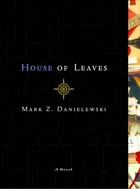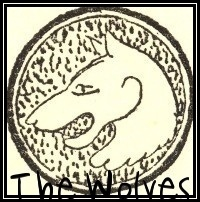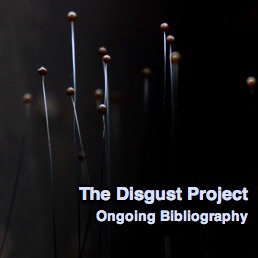
The plot of Mark Danielewski's House of Leaves involves a spatially unbounded, ever-shifting labyrinth that sprawls beneath a suburban Virginia home, exhausting, maddening, and eventually devouring (almost) everyone who dares to enter—and on many occasions while reading the novel I too felt in danger of getting crushed under the book's labyrinthine narrative. Not because of the effectiveness of the author's scene-setting, or even the creative typesetting which twists and writhes on the page, but because of the sheer weight of the elaborate metafictional apparatus with which the novel is encrusted. More than a haunted house story or an examination of family, history, and the beast within (though it is all of these things), House of Leaves strikes me as an exercise in the aesthetics of excess.
For example. Danielewski, not content with a straight-ahead story or a single frame narrative, gives us a setup wherein anonymous editors remark on the copious, Charles Kinbote-style footnoting job done by young punk Johnny Truant on a faux-scholarly manuscript written by blind immigrant Zampanò—a mass of analysis on a film, The Navidson Report, which does not exist even in the world of the book, being either Zampanò's delusion or his fictional creation. And in case this triple-nested narrative, in which every level of editor comments on every other level, is not enough, Danielewski throws in an extra 200 pages of appendices containing everything from scrawled sketches, to personal letters, to surprisingly sophisticated poems supposedly written by Johnny Truant while in Europe. (The only things missing from the appendices are, of course, the materials Zampanò himself intended to include; this is the kind of joke Danielewski loves.) There is a film-within-a-film-within-the-book in which real-life celebrities like Harold Bloom, Camille Paglia and Stephen King comment on The Navidson Record while trying to hit on its director's wife—an section that, while hilarious and well-executed, is also insanely self-indulgent and seems, at least at first, to add little to the novel as a whole. Everything about House of Leaves is so flamboyantly complicated, self-consciously clever and self-referential that I passed through phases of eye-rolling impatience and muttered imprecations until eventually emerging into a clearing of wry amusement, in which I was forced to take the book on its own terms: calling it "overdone" seems beside the point. Like so much gothic fiction, the novel's overdoneness is part of its charm, even if it is overdone in a slightly different way than most.
Take the footnotes. Regular readers know I strongly dislike the Foster-Wallace-esque use of ironically overdone footnotes in modern fiction. Blogging friend Anthony provided me with the perfect articulation of my feelings when he quoted Noel Coward's quip that encountering a footnote is like going downstairs to answer the doorbell while making love. But In Danielewski's hands the footnotes get so bizarrely baroque that the experience is more like: making love; getting interrupted by the doorbell; going downstairs; opening the door to some kid delivering a pizza you didn't order; following the pizza delivery kid down to the docks; getting into a fistfight; stowing away and ending up somewhere in Japan. At which point complaining about lack of sexual satisfaction seems strangely inadequate. Not only are the footnotes often themselves footnoted—and every possible clever footnote joke is carried out here, from hiding all the sex scenes in the footnotes, to footnotes on foreign-language passages which refuse to translate them, to footnotes that go on for several pages, to footnotes that refer back or forward 100 pages from one's current textual location, to footnote feedback loops that lock the reader into a referential circle, to footnotes that consist of only blank lines—but in one case we get footnotes six levels deep, with most of the page-long sixth-level footnote being itself crossed out. Plainly, at this stage criticizing the text for lack of restraint is missing some kind of fundamental precept: the whole enterprise is intentionally eschewing restraint and (perhaps) hoping to come out the other side.
But why is excess so important to this novel? The question plaguing all such postmodern and/or experimental fiction must rear its ugly head: is there any substance to House of Leaves, beyond all its structural pyrotechnics? As Karen asks her bevy of enamored experts in the film-within-a-film-within-a-book, does it all mean anything, or is it just scary? For most of the novel, I assumed that the whole elaborate apparatus of House of Leaves was a very complex way of making the point that everything is open to interpretation, that it's impossible to tell a true story because as soon as you begin documenting events you are already dealing with a simulacra, and that even if you could somehow manage to speak truth, it wouldn't matter as there is no "meaning" behind events to begin with. And Danielewski certainly dwells at length on points like these, conjuring a heated (if imaginary—remember that in the "real world" of the book, the film doesn't exist) debate about the authenticity of the Navidson Record, in which "slick" and "grainy" filmic aesthetics are exposed as equally manufactured, and one of the most compelling arguments for this film's documentary reality is simply that none of the filmmakers had the money to fake it:
They just never had enough money.
Sonny Beauregard conservatively estimates the special effects in The Navidson Record would cost a minimum of six and a half million dollars. Taking into account the total received for the Guggenheim Fellowship, the NEA Grant, everyone's credit limit on Visa, Mastercard, Amex etc., etc., not to mention savings and equity, Navidson comes up five and a half million dollars short. Beauregard again: "Considering the cost of special effects these days, it is inconceivable how Navidson could have created his house. Strangely then, the best argument for fact is the absolute unaffordability of fiction.
Thus reality becomes a kind of default for the poor man who can't afford anything better, and IRS records are more convincing then the evidence of our own eyes. Of course, given that the entire fiction of the Navidson Record film is created, in the world of the book, by an ancient and poverty-stricken blind man, we are, perhaps, meant to dwell on differences between media, the resources required to create convincing simulacra in words versus images, and the corresponding differences in our levels of belief. Is it easier to believe in the truth of a film because we see it with our own eyes, or more difficult because we know all the ways in which film can be manipulated? Are Johnny Truant's dread-filled and sometimes unreliable footnotes and appendices more convincing than Zampanò's text, since Truant's commentary creates the illusion that he shares our world, the world of the observer and analyst? And if there is no "meaning" attached to any of these real or faked stories, what is our investment in their reality or lack thereof?
Besides, not only can we not tell—or even sometimes care—what's real outside ourselves, but we're likely reading little more than ourselves into a work in the first place. One of the functions of all the elaborate setup is that, like the panel of experts whom Karen asks to respond to her film-within-a-film-within-the-book, Danielewski's hall of mirrors eventually makes it clear that most people, when they look at a piece of art, see only the reflection of themselves. When Johnny Truant reads and becomes obsessed with The Navidson Record, it's the ghosts of his own past that come back to him; when Harold Bloom watches Karen's film about the haunted house, he sees his own pet theories on the anxiety of influence, and when Navidson himself enters the labyrinth under his house, he's eventually left with absolutely no visual or tactile input except what's inside his own body and head. The minotaur at the center of the labyrinth is us, as all the unsuccessfully expunged footnotes indicate, and we are perfectly capable of tearing ourselves into shreds—or, occasionally, showing ourselves compassion.
Notes on Disgust
(for more information on the disgust project, see here)
For a book that's ostensibly a horror story (at least part-time), there is remarkably little explicit disgust in House of Leaves. Less than your average Edith Wharton novel, for example. And this is interesting on a couple of levels. On one hand, suggests that disgust is a bit of an intermediate emotion: generally characters can't be simultaneously disgusted and petrified with horror. In House of Leaves, the characters' experiences progress from domestic or mundane, to slightly creepy, and then straight from there to shuddering with existential dread or outright terror. There is one scene, for example, in which our post-punk narrator Johnny Truant is so scared that he loses control of his bowels while at work; in most situations, having one's pants full of shit would be a gross-out, but since Johnny believes he is about to get ripped limb from limb by some kind of vicious monster, it's not his top concern. Likewise, by the time Truant allows his apartment to generate into a filthy mess that probably would disgust us could we see or smell it, his mental state is too far gone to register that disgust or communicate it to us. Most of the book works like this: there's just not a lot of space in which the characters have the luxury of being disgusted without the disgust being trumped by terror, and it's tempting to extrapolate from here some general rule about disgust.
On the other hand, this split between fear and disgust isn't necessarily a constant. There are plenty of horror films, for example, that combine the scary with the disgusting. Over Twitter the past few days, Sarah and I have been having come great conversations about House of Leaves and the Aliens franchise (two different, unrelated conversations). Regular readers here probably imagine I have a strong stomach because of the disgust project, but in reality I'm a total wuss about gross-out films, and I've been avoiding the Aliens movies for that reason, even though the prospect of a kick-ass Sigourney Weaver is hard to pass up. Anyway, it got me thinking: films featuring monsters or zombies that drip pus, ooze, or other bodily substances while also threatening the protagonists manage to combine disgust and fear with very little problem. Maybe the difference is that, while the film's audience can be startled and drawn into the suspense of the story, they still know that they are not in real danger and so have that part of their brains free for the disgust reaction. Whereas, even in a film, when a character is in a life-or-death situation he or she is probably going to prioritize the fear and adrenaline over the "eww" factor.
In House of Leaves, in any case, the horror is all pretty non-disgusting. Unless you consider getting hit on by Harold Bloom or Camille Paglia disgusting, that is.
House of Leaves was the October selection for the Wolves reading group, and I am scandalously late posting about it, for which I really apologize. And also apologize for the several months of non-posting. This month: Nathalie Sarraute's The Planetarium.

